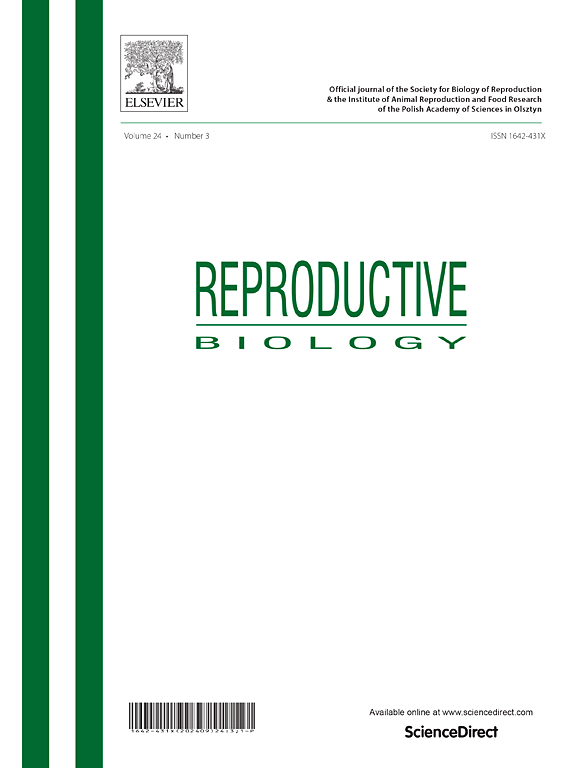酮洛芬和美洛昔康对大鼠远端尾状腱收缩、睾酮水平和精子数量的负面影响
IF 2.5
3区 生物学
Q3 REPRODUCTIVE BIOLOGY
引用次数: 0
摘要
酮洛芬和美洛昔康是广泛应用于临床的非甾体抗炎药,但它们对男性生殖健康的影响,尤其是对附睾管收缩和精子参数的影响,还缺乏全面的研究。因此,本研究探讨了酮洛芬或美洛昔康对大鼠附睾管收缩、精子参数和血清睾酮水平的负面影响。首先,我们在体外评估了酮洛芬或美洛昔康(1-100 μM)对去甲肾上腺素引起的附睾管收缩的影响。在对大鼠的附睾管收缩、精子参数和血清睾酮水平进行评估后,还对大鼠口服 5 毫克/千克酮洛芬或 1 毫克/千克美洛昔康,为期 15 天。体外暴露于美洛昔康(100 μM)而非酮洛芬可显著降低去甲肾上腺素在附睾管中的最大作用。此外,体内注射酮洛芬和美洛昔康可降低大鼠附睾睾帽/睾丸区域的睾酮水平、精子产量和精子数量。相反,接受酮洛芬和美洛昔康治疗的动物附睾尾部的精子数量保持不变。美洛昔康(而非酮洛芬)会延迟精子在附睾尾部的转运时间。在体内使用酮洛芬或美洛昔康会阻碍去甲肾上腺素引起的附睾管收缩。总之,酮洛芬和美洛昔康可以通过降低睾酮水平和从大鼠附睾远端尾区分离出的附睾管的收缩来改变精子参数。本文章由计算机程序翻译,如有差异,请以英文原文为准。
Negative effects of ketoprofen and meloxicam on distal cauda epidydimal duct contractions, testosterone levels, and sperm count in rats
Ketoprofen and meloxicam, non-steroidal anti-inflammatory drugs widely used in clinical practice, lack comprehensive investigation regarding their impact on male reproductive health, particularly on epididymal duct contractions and sperm parameters. Therefore, this study investigated the negative effects of ketoprofen or meloxicam on the contractions of the epididymal duct, sperm parameters, and serum testosterone levels in rats. Firstly, we assessed the in vitro effects of ketoprofen or meloxicam (1–100 μM) on the contractions of the epididymal duct elicited by noradrenaline. Rats were also orally treated with 5 mg/kg ketoprofen or 1 mg/kg meloxicam for 15 days following evaluation of epididymal duct contractions, sperm parameters, and serum testosterone levels. In vitro exposure to meloxicam (100 μM), but not ketoprofen, significantly reduced the maximum effect of noradrenaline in epididymal duct. Moreover, in vivo administration of ketoprofen and meloxicam decreased testosterone levels, sperm production, and sperm count in the caput/corpus region of the rat epididymis. Conversely, the sperm count in the cauda epididymis remained unchanged in animals treated with both ketoprofen and meloxicam. Meloxicam, but not ketoprofen, caused a delay in sperm transit time in the cauda region of the epididymis. In vivo treatment with both ketoprofen or meloxicam hindered the noradrenaline-induced contractions in the epididymal duct. In conclusion, ketoprofen and meloxicam can modify sperm parameters by decreasing testosterone levels and the contractions of the epididymal duct isolated from the distal cauda region of the rat epididymis.
求助全文
通过发布文献求助,成功后即可免费获取论文全文。
去求助
来源期刊

Reproductive biology
生物-生殖生物学
CiteScore
3.90
自引率
0.00%
发文量
95
审稿时长
29 days
期刊介绍:
An official journal of the Society for Biology of Reproduction and the Institute of Animal Reproduction and Food Research of Polish Academy of Sciences in Olsztyn, Poland.
Reproductive Biology is an international, peer-reviewed journal covering all aspects of reproduction in vertebrates. The journal invites original research papers, short communications, review articles and commentaries dealing with reproductive physiology, endocrinology, immunology, molecular and cellular biology, receptor studies, animal breeding as well as andrology, embryology, infertility, assisted reproduction and contraception. Papers from both basic and clinical research will be considered.
 求助内容:
求助内容: 应助结果提醒方式:
应助结果提醒方式:


